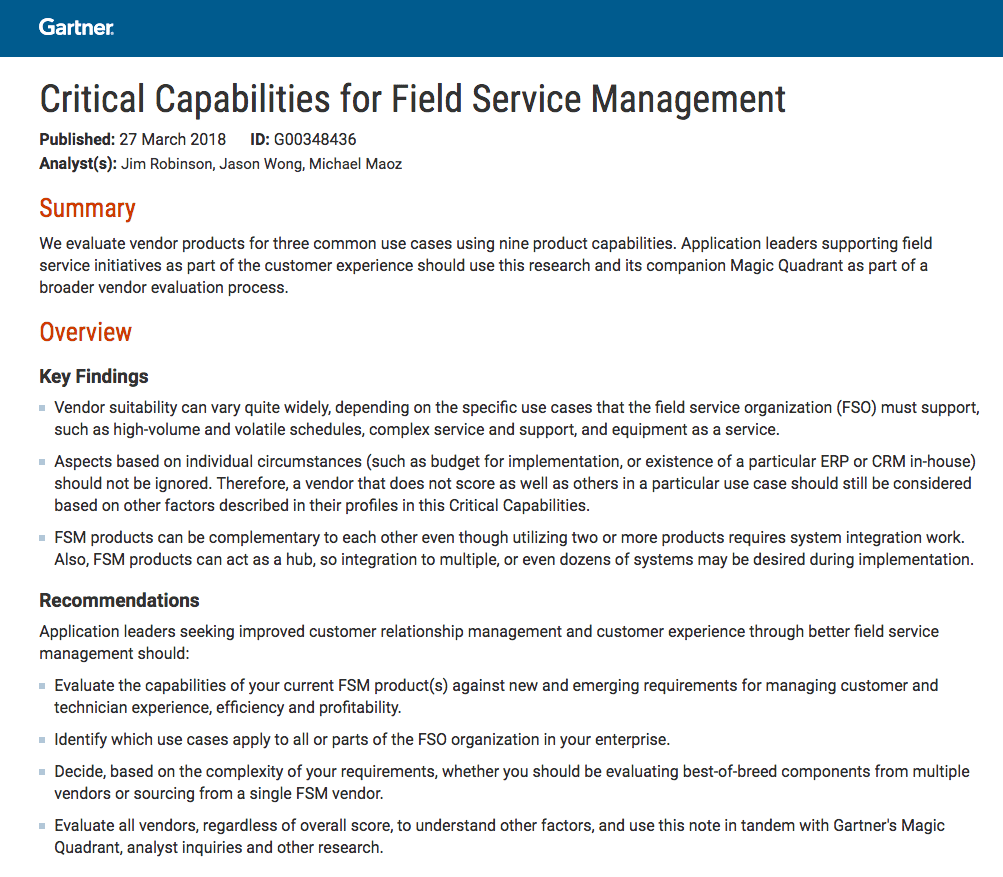Analyst firms have recognized that Field Service Management (FSM) is a hot and evolving market, with Gartner recently adding another layer to their deep coverage. The firm published “Critical Capabilities for Field Service Management” in late March, which for the first time provides detailed product ratings in nine capability areas across three main field service use cases. 16 vendors are evaluated and profiled, including GE Digital (the same 16 that were profiled in last fall’s 2017 Magic Quadrant for FSM, in which ServiceMax from GE Digital was named a Leader).
While we believe ServiceMax’s scores were excellent (see the full report to see just how excellent), my favorite thing about this updated look at the market was analyst Jim Robinson’s decision to look at the market through three different lenses. He chose three main use cases that organizations looking to transform their field service delivery often explore. They are:
- Equipment as a Service
- Complex Service and Support, and
- High Volume and Volatile Schedules
Companies looking at field service technology are often driven by one or two of these use cases, but rarely do they explore all three at once. Most will value a very different set of capabilities depending on which of these use cases is of paramount importance. Take, for example, an industrial manufacturer that has complex service needs to support various contracts, service plans, pricing, and requires a crew working in a specific order to complete the maintenance or repair. This organization does have scheduling needs but at a different scale – they may need to fly in a PhD to work on a particular machine. Their engineers are not making 5 visits to 5 different customers in one day. On the other hand, take the case of a home health care business scheduling nurses for hundreds of home visits, or a cable company installing set top boxes. There are volatile, high volume scheduling needs, and multiple visits per day but probably very little complexity once they arrive at the customer, as each visit is similar. Both of these examples are “field service” but there are vastly different needs.
Lastly, let’s look closer at the Equipment as a Service use case, for which ServiceMax scored highest. This is a major, disruptive trend that is leading many organizations to rethink their entire service delivery model. It goes beyond adding sensors to make machines “IoT enabled”, but also supports changing the company’s business model to one that delivers outcomes to a customer vs. selling a product + a service. Think leasing document services for your office, versus buying a copy machine, ink and paper, and then paying a service company when something is broken.
Again, there are vastly different needs here, and ServiceMax has led the way to deliver Connected Field Service to the market. As part of GE Digital, our value is enhanced with our ability to integrate to Predix and Asset Performance Management, (APM) so that actions can be taken on the equipment insights and strategies that APM recommends. The actions not only include generating a work order, but also the ability to price and manage preventive service contracts, and better predict when service will be needed for optimum equipment uptime. While all three use cases are powerful and deliver valuable business results, this is truly the future.
So access the report with our compliments, and dig into which use cases and capabilities matter to you and your business. Happy reading!



Share this: